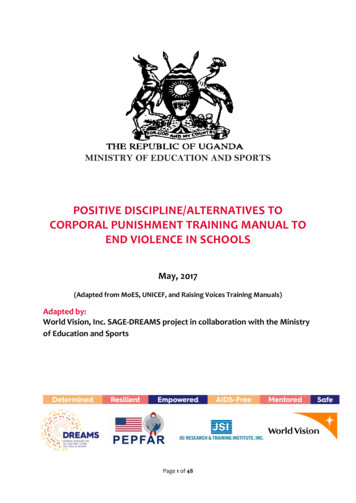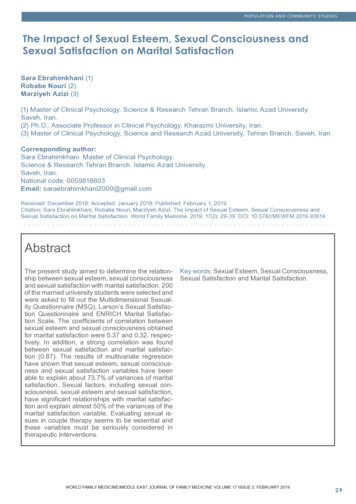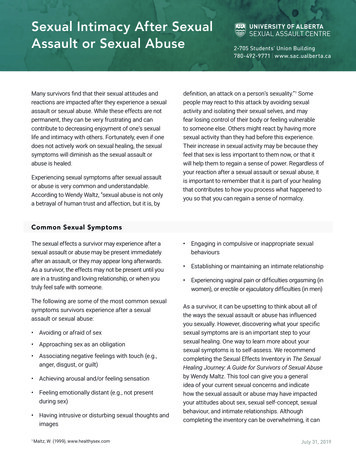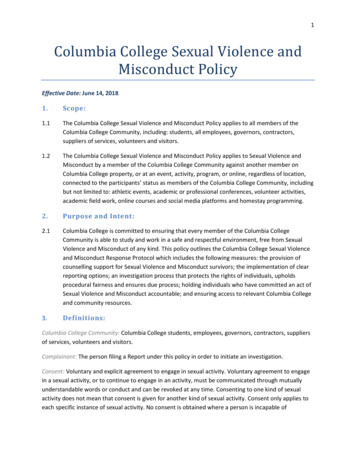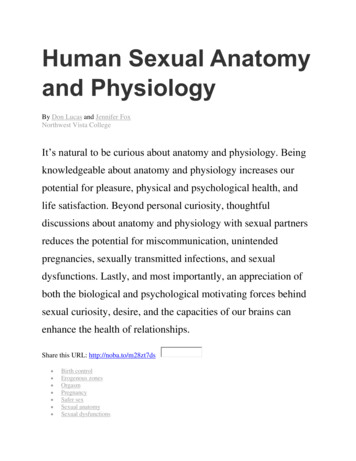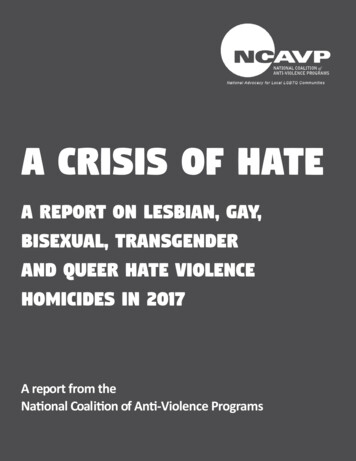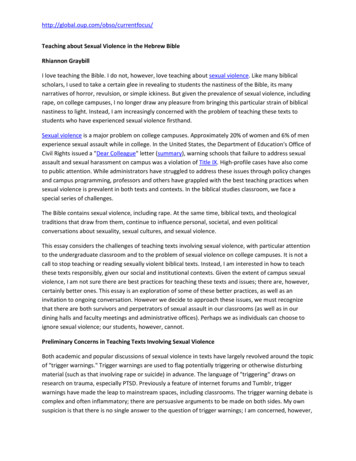
Transcription
http://global.oup.com/obso/currentfocus/Teaching about Sexual Violence in the Hebrew BibleRhiannon GraybillI love teaching the Bible. I do not, however, love teaching about sexual violence. Like many biblicalscholars, I used to take a certain glee in revealing to students the nastiness of the Bible, its manynarratives of horror, revulsion, or simple ickiness. But given the prevalence of sexual violence, includingrape, on college campuses, I no longer draw any pleasure from bringing this particular strain of biblicalnastiness to light. Instead, I am increasingly concerned with the problem of teaching these texts tostudents who have experienced sexual violence firsthand.Sexual violence is a major problem on college campuses. Approximately 20% of women and 6% of menexperience sexual assault while in college. In the United States, the Department of Education's Office ofCivil Rights issued a "Dear Colleague" letter (summary), warning schools that failure to address sexualassault and sexual harassment on campus was a violation of Title IX. High-profile cases have also cometo public attention. While administrators have struggled to address these issues through policy changesand campus programming, professors and others have grappled with the best teaching practices whensexual violence is prevalent in both texts and contexts. In the biblical studies classroom, we face aspecial series of challenges.The Bible contains sexual violence, including rape. At the same time, biblical texts, and theologicaltraditions that draw from them, continue to influence personal, societal, and even politicalconversations about sexuality, sexual cultures, and sexual violence.This essay considers the challenges of teaching texts involving sexual violence, with particular attentionto the undergraduate classroom and to the problem of sexual violence on college campuses. It is not acall to stop teaching or reading sexually violent biblical texts. Instead, I am interested in how to teachthese texts responsibly, given our social and institutional contexts. Given the extent of campus sexualviolence, I am not sure there are best practices for teaching these texts and issues; there are, however,certainly better ones. This essay is an exploration of some of these better practices, as well as aninvitation to ongoing conversation. However we decide to approach these issues, we must recognizethat there are both survivors and perpetrators of sexual assault in our classrooms (as well as in ourdining halls and faculty meetings and administrative offices). Perhaps we as individuals can choose toignore sexual violence; our students, however, cannot.Preliminary Concerns in Teaching Texts Involving Sexual ViolenceBoth academic and popular discussions of sexual violence in texts have largely revolved around the topicof "trigger warnings." Trigger warnings are used to flag potentially triggering or otherwise disturbingmaterial (such as that involving rape or suicide) in advance. The language of "triggering" draws onresearch on trauma, especially PTSD. Previously a feature of internet forums and Tumblr, triggerwarnings have made the leap to mainstream spaces, including classrooms. The trigger warning debate iscomplex and often inflammatory; there are persuasive arguments to be made on both sides. My ownsuspicion is that there is no single answer to the question of trigger warnings; I am concerned, however,
http://global.oup.com/obso/currentfocus/that the debate over trigger warnings, however deleterious or desirable, threatens to overshadow othersteps that faculty can and should take in the classroom to address sexual violence.Sexual violence is not an abstract hypothetical to our students; our teaching must reflect this reality,without, however, singling out or making assumptions about the experiences of particular students. Anygiven class likely contains both survivors and offenders. There are often other students who mayinadvertently make insensitive comments, or who simply don't realize the scale of the problem. Andthen there are students who, motivated by discomfort or other reasons, make light of sexual violence.All this, of course, is on top of the ordinary issues in teaching, and in the teaching of biblical texts. Still,recognizing this broad range of experiences, knowledges, and past traumas (of many kinds) is a crucialfirst step of empathy. These issues in the classroom offer the opportunity, and perhaps the obligation,to engage the situation on campus more directly.Rape and Rape CultureFrom the outset, there are difficulties in discussing rape in the Hebrew Bible. Biblical Hebrew does nothave a single word that unambiguously means "rape." A related difficulty is that biblical law seems tolimit women's control of their own sexuality, which makes it difficult to apply the modern notion ofconsent. This is especially at issue, for example, in Genesis 34, the narrative of the rape of Dinah,discussed further below.Another key concept in talking about rape is rape culture. As the phrase suggests, rape culture refers notto specific actions, but larger cultural attitudes toward gender and sexual violence. Rape culturedescribes the normalization of sexual violence and its links to broad patterns of misogyny and sexism.Purity culture is another component of rape culture—the idea that women should remain pure and thatsexual activity renders a woman "used" or "dirty." The term rape culture originated with feministactivists and scholars in the 1970s but has achieved a broad degree of recognition more recently. Thephrase is especially common in internet feminist spaces; it is also increasingly used in campusprogramming related to preventing sexual violence. Women are not the only victims of sexual violence;neither is sexual violence exclusively heterosexual. Transgender and queer people are especiallyvulnerable to sexual violence. The White House-sponsored " It's On Us" campaign, for example,emphasizes rape culture instead of individual acts of sexual violence.As with "rape," the absence of a term for "rape culture" in biblical Hebrew does not mark its absence.Instead, many of the features that contemporary commentators identify as central to rape cultureappear in the Hebrew Bible. Acts of sexual violence in the text are clearly connected to larger attitudesof misogyny. The text frequently engages in victim blaming, as when Yahweh describes Israel(represented as a woman) as promiscuous before promising to sexually humiliate her (Hos. 2; Ezek. 16;23). Female sexuality in general is an object of both fascination and disgust; this interest is paired withthe high value placed on female virginity (male virginity receives no such special attention). Furtherreflecting the intersections of gender and power in the ancient world, biblical law does not distinguishbetween rape and adultery. Deuteronomy 22:22 reads, "If a man is caught lying with the wife of anotherman, both of them shall die, the man who lay with the woman as well as the woman. So you shall purge
http://global.oup.com/obso/currentfocus/the evil from Israel." The law provides no exception to this punishment if the woman was raped, sinceshe did not cry for help (Deut. 22:24). If, however, the woman was raped in the fields, where no onecould hear her cries for help, she will not be killed (Deut. 22:25). Deuteronomy 21:10–14 says that a manwho captures a woman as bounty in wartime cannot marry her or engage in sexual activity with her forone month; after this time, such actions are presumed acceptable.What does it mean to employ the analytical category of "rape culture" in approaching the Hebrew Bible?This mode of reading draws upon the insights of traditional forms of biblical criticism, such as thehistorical-critical method, to understand gender and violence in ancient Israel. However, a rape culturereading is not strictly limited to reconstructing the past. Instead, it intentionally juxtaposes the ancientand contemporary in order to better understand and respond to sexual violence. This mode of reading isless concerned with historical or comparative legal questions. It is, instead, centrally concerned withwhat Paul Ricoeur called the "world in front of the text" and with the students sitting in front of us inclass. In this way, reading for rape culture resembles feminist, queer, and postcolonial readings thatbridge ancient texts and modern concerns.Reading for rape culture is not the only way to approach the biblical text; indeed, I would suggest thatreading only with an eye to sexual violence and misogyny forecloses other horizons of interpretivepossibility, including many feminist ones. But for the purposes of teaching, especially to students livingin rape culture, it is important to pause and take seriously the intersections between biblical texts andrape cultures. One place to begin this examination is with the Bible's own most notorious rape stories.The Rape of Dinah (Gen. 34)Dinah, Jacob's only daughter, is headed out into the fields to visit the "women of the region" (Gen. 34:1)when she is overpowered by Shechem. After raping her, he wishes to marry her. Her brothers, Simeonand Levi, demand that he and his men be circumcised before the marriage occurs; while they arerecovering, all of Shechem's men are killed by Dinah's brothers. When Jacob challenges them, theyreply, "Should our sister be treated like a whore?" There is some uncertainty over the nature ofShechem's actions toward Dinah; they have been interpreted as rape but also as consensual premaritalsex. This latter approach is advocated for, for example in Anita Diamant's The Red Tent (now a Lifetimeminiseries as well), which treats Dinah's experience as a doomed love story. A third possibility isacquaintance rape—Shechem was known to Dinah, perhaps even well, but the sexual encounter wasnonconsensual. Part of the difficulty is the absence of Dinah's perspective on the event, as well as thelack of language and even concepts of "consensual" and "consent."In many ways, the narrative of Dinah is valuable as a way of thinking through the larger issuessurrounding rape, female sexuality, and the status of women in the biblical text. Dinah's sexuality ispresented as something to be negotiated and exchanged among men. (If her brothers Simeon and Leviare acting on her instructions or in accordance with her wishes, the text does not share this detail). It isat this point that a traditional anthropological or historical reading and a radical feminist readingagree—an uncommon point of rapport and one perhaps worth exploring. Feminist anthropologist GayleRubin has traced "the traffic in women"; the rape of Dinah is also a clear example of such a theme. It can
http://global.oup.com/obso/currentfocus/also be valuable to reflect on the process of interpreting the text. The idea that "she wanted it" or "shewas asking for it" (by going to visit "the women of the region," by attending a fraternity party, orwhatever else) is a persistent feature of rape culture; to insist that a narrative of rape is really a lovestory is to repeat this trope and even to perpetuate further violence against Dinah. But what if Dinah diddesire Shechem, and consented to the encounter? Is not also anti-feminist to foreclose the possibility offemale desire and even sexual agency in the text? While these questions have no simple answers, askingthem is one of way entering into the complexities of the issue.The Rape of Tamar (2 Sam. 13)The rape of Tamar repeats many of the themes of the rape of Dinah. David's son, Amnon, is seized bydesire for Tamar, his half-sister. Counseled by his friends, he pretends to be ill; when Tamar brings himfood, he rapes her in spite of her protests. He is then "seized with a very great loathing" (2 Sam. 13:15)and casts her out. Tamar's full brother Absalom subsequently kills Amnon and David's family begins tounravel; of Tamar, however, no more is heard. As in the case of Dinah, the narrative of Tamar representsthe sexual use of women as a means of establishing power relations between men. Tamar is not givenagency in the story; her voice is not heard except in protest. Absalom seeks to defend his sister, and yeta few chapters later in the text, he has sex with his father's concubines as a means of asserting his claimto the throne (2 Sam. 16:21–22).In the context of recent conversations about sexual assault and sexual violence on college campuses, thestory of Tamar displays several disturbing parallels. Jonadab encourages Amnon to trick Tamar intobeing alone with him; this sort of male conspiracy to isolate women and subject them to sexual violencehas parallels in modern rape cultures, including those in many college fraternities. Amnon likewise playson Tamar's instincts to compassion and hospitality, an exploitation of gendered kindness.As with Dinah, the very act of reading the narrative of Tamar offers a window into larger issues ofgender, power, and rape culture. Some scholars have suggested, for example, that Tamar sought toentrap Amnon in marriage when she visited him, and that the "rape" was the after-the-fact invention ofa jilted would-be wife. The parallels between this reading and modern tropes of rape culture hardlyneed to be stated, beginning with the assumption that rape claims are simply stories women tell afterdeciding they made a mistake.The Levite's Concubine (Judg. 19) and Lot's Daughters (Gen. 19)Perhaps the most notorious rape narrative in the Hebrew Bible is the story of the Levite's concubine inJudges 19. A Levite and his concubine are traveling through the land of Benjamin and must spend thenight in Gibeah. A man gives them shelter for the night, but the men of the city surround the house anddemand the opportunity to rape the Levite. In a move reminiscent of Genesis 19, the host offers insteadthe concubine and his own virgin daughter; the men refuse, but the Levite pushes out his concubine.She is raped all night and discovered in the morning. The Levite cuts her body into twelve pieces andsends one to each tribe of Israel, summoning them to war against Benjamin. (Whether the woman isdead before she is cut up remains unaddressed by the text).
http://global.oup.com/obso/currentfocus/This narrative has been identified as a "text of terror" by many biblical scholars, and rightly so. Thesexual violence is appalling. While it is the men of Gibeah, described by the text as a "perverse lot"(Judg. 19:22, NRSV), who are initially responsible, the Levite and his host are also implicated in the text'sviolence. The apparent interchangeability of potential rape victims (the Levite, the daughter, theconcubine) points to a larger ideology of rape culture. There is also the emphasis placed on thedaughter's virginity, as well as the detail that she is ultimately spared, unlike the previously sexuallyexperienced concubine. Here, as with the concubines in 2 Samuel 16, status is mapped onto sexuality:free (and virginal) versus slave (and sexually possessed by all).This points to the value placed on virginity, itself linked to modern purity cultures and the so-called"virgin/whore dichotomy."1 Purity culture is itself a form of rape culture, as many scholars andcommentators have noted. Furthermore, none of the women in either Judges 19 or Genesis 19 are givennames. Many feminist interpreters have discussed the significance of this lack of names; I want only toadd here that it furthers the effect of representing women as interchangeable sexual commodities. It isnot neutral that this rape victim is known in the literature only as the Levite's concubine. (See, e.g., the"Index of Women" on the OBSO site).Considering Judges 19 intertextually with Genesis 19, the destruction of Sodom and Gomorrah, furtherdraws out the text's complicity in sexual violence. In the Genesis story, Lot offers his daughters, who"have not known a man" (Gen. 19:8), to the crowd of men who desire to rape his male guests(themselves divine messengers). The emphasis on the daughters' virginity parallels the emphasis on thehost's daughter's virginity in Judges 19, just as the fact that Lot's daughters are spared also plays intobinary logic of virgin-whore dichotomy. The attempt of the men of Sodom to rape the guests, as well asLot's attempt to provide alternate targets (his own daughters) point to the larger economy of sexualviolence, including the interchangeability of victims, that underlies both texts. In the aftermath ofSodom's destruction, Lot himself is raped by his daughters, who believe there is no other man left aliveto father children (Gen. 19:32–38). Some readers, such as Ilona Rashkow, have suggested that Lot in factrapes his daughters, and the text as written reflects either bad conscience or an intentional cover-up. Analternate perspective, one that accepts the daughters as initiators, raises the question of rape of males,as well as the silence that surrounds it. Is it impossible that the daughters initiate the rape because suchviolence against a male body is unthinkable, or because rape, including family rape, is such a pervasivepart of the female experience?Returning to Judges 19, a critique of rape culture must take seriously the larger contexts of the rape ofthe Levite's concubine. Within the narrative arc of Judges, the rape and murder of the concubine lead toa war against Benjamin, causing the other tribes to refuse intermarriage with Benjamin. TheBenjaminites' response is to kidnap a host of virgins from Jabesh-gilead and from Shiloh. As in Genesis19, the response to sexual violence is more sexual violence. These events, moreover, come as theculmination of the repeated gender violence that constitutes the overall structuring logic of the book ofJudges. The intertextual connections with Gen. 19, meanwhile, indicate that rape culture is not limitedto Judges or to "those days [when] there was no king in Israel; all the people did what was right in theirown eyes" (Judg. 21:25). Instead, it is pervasive across biblical texts, times, and authors.
http://global.oup.com/obso/currentfocus/Other Instances of Rape CultureRape culture also plays out in the use of sexual violence as a means of punishment, either in personalrelationships or as an act of war. In multiple texts, Yahweh punishes Israel (represented as a woman)with sexual humiliation. Yahweh threatens to strip naked women who are sexually promiscuous ordressed in jewelry or other finery; it is worth noting that dress is taken as an indicator of sexuality, acommon assumption in rape culture as well. The trope of the punishment of the promiscuous woman isespecially pronounced in the marriage metaphor texts, such as Hosea 2 and Ezekiel 16 and 23, wherethis woman is Israel.Exposure and sexual humiliation are also directed at men. The stripping of male prisoners of war is ameans of punishment documented in many ancient Near Eastern texts.2 The rape of women alsosometimes figures in the text, including the sexual use of women captured in warfare. This reflects theunderstanding of female sexuality as an extension of masculine economies of power and control. Thereare also narrative examples. Judges 19–21 offers one extended narrative on the intersections of rapeand warfare. In addition, biblical rape culture is inseparable from the larger issue of the representationof foreigners. Deviant sexuality is frequently associated with foreign peoples, with the tropes of thesexually promiscuous woman and the sexually deviant homosexual man given particular prominence.Foreign peoples prove both sexually compelling and deeply dangerous to the ancient Israelites.Numbers 25 offers a sharp example. The high priest Phinehas encounters the Israelite man Zimri and theMoabite woman Cozbi in flagrante and stabs them both with a single thrust—an image of violence withvisual parallels to rape. His actions are commended by the text's authors. Sexualized violence is adivinely ordered punishment.It is not only the explicit narratives of rape that represent rape culture in the biblical text. Instead, rapeculture as a category forces us to look beyond single events to larger conditions of culture. It alsorequires us to reexamine our assumptions about seemingly familiar texts. Consider, for example, thetheme of the "barren matriarchs" in Genesis. The use of slave women (Hagar, Zilpah, Bilhah) for thematriarchs is often discussed as a kind of surrogacy. And yet it is equally possible to read thesenarratives as stories about the sexual exploitation of slaves. This is a point that recent feminist,womanist, and postcolonialist critiques of Genesis (and, indeed, of biblical scholarship) have drawn out;it is also given vivid literary form in Margaret Atwood's The Handmaid's Tale. The narrative of David andBathsheba, often represented in artistic representations as a great love story, is another story that raisestroubling issues of consent. While David's desires are clear in the text, Bathsheba's remain unstated; shenever gives consent. Interpreters sometimes take her action of bathing on the roof as an invitation tosexual activity; this evokes the common rape culture narrative of "asking for it." The David andBathsheba story also raises the issue of power: David as king has significant power over Bathsheba (and,indeed, everyone else); this constrains Bathsheba's possible responses to the king's sexual propositions.This is especially worth attending to in an academic context, with its own issues of power relations (bothas a topic of study and as a lived experience in the classroom).The intersections of sex and deceit in Genesis, such as Lot's sexual relations with his daughters orTamar's with Judah (Gen. 38), represent another thread of rape culture in the text. The narrative of Lot's
http://global.oup.com/obso/currentfocus/daughters, like that of Dinah, also raises questions of agency: do the daughters in fact initiate sexualactivity, or does the text reflect an attempt to repress and renovate the parental rape of a child? (This isthe argument of Ilona Rashkow, here and in her reading of Noah and Ham; Rashkow argues that Noahrapes his son Ham and the text constructs a cover-up.3) Given the prevalence of alcohol in sexualassaults on college campuses, the drunkenness of Noah and Lot is also pertinent.The narrative of Lot and especially of Noah and Ham also raises the question of sexual violence againstmen. Discussions of rape culture often emphasize the ways in which norms of masculinity constitutemen as sexual agents and women as passive prizes and/or victims. This representation has manynegative consequences for women, including the representation of survivors of sexual violence as"damaged" (as in Judg. 19). However, it is also negative for men. A significant number of men are victimsof sexual violence, and yet this experience remains undiscussed and even unthinkable under theparameters of rape culture. In the Hebrew Bible, there are a few scattered references to sexual violenceagainst men (e.g., Jer. 20:7, as well as the narratives of Noah and Lot). Sexual violence against malebodies is typically represented as an assault on masculinity more broadly.Additional Reflections on TeachingAs a way of entering more deeply into the topic, I want to consider in greater detail a particularpedagogical example: Genesis 34. In teaching this text, I have multiple goals for my students. First, aswith other texts, I want them to see that the narrative sustains multiple ways of reading (in terms ofapproaches—historical, literary, and so forth—and interpretations of what happens to Dinah). Second, Iwant them to link the reading of this text to other larger concerns, such as the status of women inancient Israel and the control of female sexuality by men. In addition, I use this lesson to introducestudents to the idea of rape culture (as a concept, as well as a way of approaching or interpreting texts).And finally, I want to make students aware of the existence of campus resources and policies.This is a significant amount of material to cover in a class session, and of course there are almost alwayscomplications. (Is there an exam to prepare for? A paper to explain? Another text to discuss? Is thecampus in the thrall of preparing for Homecoming or Parents' Weekend?) Still, I make a dedicated effortto carve out a significant portion of the class to reading and discussing Dinah, without making thestudents feel rushed. This allocation of time is itself a way of signaling the importance of the topic. I alsobegin with a brief statement about taking the text seriously and treating it with respect. I also explain,briefly, the concept of rape culture, which I use as a framing device for this lesson; this fits into a largerclass theme about exploring the various methods that biblical scholars use.I combine several classroom strategies to achieve the lesson's objectives. The status of women inancient Israel is a topic that I introduce with a brief lecture or perhaps a reading assigned prior to class.For the initial analysis of the text, on the other hand, I have students begin by discussing with a partner,which creates less vulnerability than a large class discussion. It also allows me to listen in and be attunedto possible issues to address—or head off—in the group discussion that follows. Similarly, while I oftencold-call on students to increase participation, I generally avoid doing this in the context of a topic suchas sexual violence. At the same time, I am careful to maintain academic rigor in both lecture and
, to avoid suggesting that sexual violence is unrelated to "real" academic concerns. I include abrief mention of campus resources into the class discussion, and follow up with an email link to therelevant campus web resources.These strategies, of course, reveal something about my own institutional contexts—teaching a small,discussion-based class of primarily first-year students. However, the general principles are adaptable toa range of contexts, including large lectures and online classes. A well-planned and well-executed classon sexual violence in the biblical texts can make a powerful if implicit statement about the importanceof taking sexual violence seriously as a problem. Equally important is the attitude that the professormodels. With difficult texts and situations in particular, our students look to us for how to respond;teaching these texts with sensitivity is an important pedagogical gesture. As a reader, I am not especiallyconcerned about the problem of doing violence to a text, or to a text's characters. I am, however,concerned by the risks of teaching texts in ways that do harm to students.There are other teaching strategies to mention. One is to attend to time. The highest risk period of timefor young women, for example, is often identified as that falling between the beginning of the fallsemester and the Thanksgiving break of the first year, a time referred to as the "red zone."4 Otherstudies have pointed to fraternity and sorority rush as times of increased risk.5 Time comes into play inquestions of pedagogy as well. It is helpful to think intentionally about when in the semester theseconversations should occur. How comfortable are students with each other, and with difficultconversations? Are these conversations better carried out in a large group, guided by the instructor, orin small groups, where students may feel less vulnerable? Perhaps most importantly, is there a dynamicof respect and trust?Whatever choices we as instructors make, we should make them with reflection and compassion.Teaching texts of sexual violence in the Hebrew Bible is both difficult and important. Above all, it is atask we owe it to our students to do well.Notes1Jessica Valenti. The Purity Myth: How America's Obsession with Virginity Is Hurting Young Women(Berkeley, CA: Seal Press, 2009), 13–14.2On the feminizing of male captives, see Cynthia R. Chapman. The Gendered Language of Warfare in theIsraelite-Assyrian Encounter, Harvard Semitic Monographs 62 (Winona Lake, IN: Eisenbrauns, 2004).3Ilona N. Rashkow. Taboo or Not Taboo: Sexuality and Family in the Hebrew Bible (Minneapolis, MN:Fortress, 2000), 96-104.4Matthew Kimble PhD et al. "Risk of Unwanted Sex for College Women: Evidence for a Red Zone,"Journal of American College Health 57, no. 3 (November 1, 2008): 331–38; Stephen Cranney, "TheRelationship Between Sexual Victimization and Year in School in U.S. Colleges Investigating theParameters of the 'Red Zone,'" Journal of Interpersonal Violence 30, no. 17 (October 1, 2015): 3133–45.
http://global.oup.com/obso/currentfocus/5William F. Flack et al. "'The Red Zone' Temporal Risk for Unwanted Sex Among College Students,"Journal of Interpersonal Violence 23, no. 9 (September 1, 2008): 1177–96.BibliographyTexts about Sexual Violence and the Bible Gadotti, Alhena. "Why It Was Rape: The Conceptualization of Rape in Sumerian Literature."Journal of the American Oriental Society 129, no. 1 (January 1, 2009): 73–82. Gravett, Sandie. "Reading 'Rape' in the Hebrew Bible: A Consideration of Language." Journal forthe Study of the Old Testament 28, no. 3 (March 1, 2004): 279–99. Scholz, Susanne. "'Back Then It Was Legal' The Epistemological Imbalance in Readings of Biblicaland Ancient Near Eastern Rape Legislation." Journal of Religion & Abuse 7, no. 3 (November 2,2005): 5–35. Scholz, Susanne. Sacred Witness: Rape in the Hebrew Bible. Minneapolis, MN: Fortress, 2014. Trible, Phyllis. Texts of Terror: Literary-Feminist Readings of Biblical Narratives. Overtures toBiblical Theology. Philadelphia: Fortress, 1984.Texts about teaching difficult texts (often with reference to Greek and Roman materials) Gloyn, Elizabeth. "Reading Rape in Ovid's Metamorphoses: A Test-Case Lesson."Classical World 106, no. 4 (2013): 676–81. Kahn, Madeleine. Why Are We Reading Ovid's Handbook on Rape?: Teaching andLearning at a Women's College. Boulder, CO: Pa
Sexual violence is a major problem on college campuses. Approximately 20% of women and 6% of men experience sexual assault while in college. In the United States, the Department of Education's Office of Civil Rights issued a "Dear Colleague" letter (summary), warning schools that failure to address sexual
